
Welcome to
*Insights by Sefunmi*
Here, I share thoughtful articles on wellbeing, science, education, and community impact. Let’s explore how everyday stories shape a better world.

More Than Pets: The Role of Dogs and Cats in Community Wellbeing
In many households, dogs and cats are not just animals - they are family. But beyond companionship, these pets play a decisive role in shaping healthier, happier communities. From reducing stress to assisting in therapy and even saving lives, their impact goes far beyond what we see.
Emotional Support and Mental Health
Both dogs and cats offer unconditional love and emotional comfort. Research shows that petting or playing with a dog or cat reduces cortisol (the stress hormone) and increases serotonin, a natural mood booster. For individuals battling depression, loneliness, or trauma, pets serve as silent healers.
Building Family Bonds
In family settings, pets bring joy, teach responsibility, compassion, and empathy. Children learn to care for others, develop routine, and form strong emotional connections. For elderly members, pets bring companionship and a sense of purpose, especially when living alone, creating a warm and connected family environment.
Therapy and Healing Partners
Therapy animals are increasingly used in hospitals, schools, and care homes. Dogs are trained to provide comfort during counselling, reduce anxiety in medical settings, and even help children with autism develop social skills. These aren't just pets - they're part of a care system.
Community Heroes
Dogs, especially, are renowned for their alertness and protective instincts. Many have been credited with saving lives, from detecting seizures to alerting owners about fires or intruders. For instance, a dog named Duke in California saved his owner from a rattlesnake bite by barking and drawing attention to the danger. Stray dogs have even rescued abandoned infants or helped lead rescue teams during disasters.
Stray Pets and Urban Safety
When cared for through shelters or community programs, stray cats help control rodent populations, and dogs deter criminal activity in high-risk areas. With proper support, these animals can become assets to public health and safety.
How You Can Help
Charities like Battersea Dogs & Cats Home go above and beyond to rescue, shelter, and rehome these amazing animals. But they need your help.
Visit www.battersea.org.uk to:
- Adopt or sponsor a pet
- Volunteer your time
- Donate to support ongoing rescue missions.
A Better World Begins With Kindness
By supporting organisations like Battersea, you're not just helping animals - you’re investing in a more compassionate and connected world.
Let’s spread the word. Let’s show that pets are more than pets.
Written by Sefunmi Oluyede
Support more awareness content like this. Follow on Pinterest, Medium, or contact me.
🔁 More inspiring stories await...
Note from Sefunmi:
This post is part of my ongoing archive of faith-based content. As a content creator and educator, I also help churches, ministries, and faith leaders turn their sermons into engaging blog posts, devotionals, summaries, and YouTube content.
If you’re a pastor, media team, or Christian author looking for professional writing or content support, click here to contact me
Enduring Faith (Pt 1)
Date: Sunday, 6th July 2025
Location: RCCG Joint Heirs Connection
Minister: Pastor Alex Oviawe
Watch on YouTube: https://youtu.be/Mp5QpFXZ_pQ
Enduring Faith - Part 1: When the Battle Is for Your Belief
Faith is not a wish. It’s not empty positivity. Faith is substance -the assurance of things hoped for, the evidence of things unseen (Hebrews 11:1). In this powerful message, Pastor Alex Oviawe takes us deep into the heart of what it means to live by faith - especially in a world full of distractions, delays, and spiritual attacks.
Key Scriptures:
-
Hebrews 11:1 - "Faith is the substance of things hoped for..."
-
Hebrews 12:1–3 - "...let us run with patience the race set before us..."
-
John 6:38 - "He that eateth of this bread shall live forever..."
-
Sermon Highlights:
-
Faith must be active, not theoretical. It is validated by obedience.
-
The enemy doesn’t fear your money, job, or comfort. He fears your faith.
-
Your Christian walk is not a quick sprint but a marathon of endurance.
-
Faith without obedience is dead. Wishing is not the same as believing.
-
When your faith is tested, remind the enemy: “You’re too late. I still believe!”
-
Reflection Questions:
-
Do I confuse wishing with genuine, obedient faith?
-
What is the devil using to try and shake my confidence in God?
-
When tested, do I have a plan B - or do I run with patience?
Want More?
Download the Full Sermon Summary (PDF)
Get the 5-Day Devotional
Watch on YouTubePowered by RCCG Joint Heirs Media
Designed by sefunmioluyede.comNeed help turning your message into content?
Hire me for Church Content Writing
-
-
Need help turning your message into content?
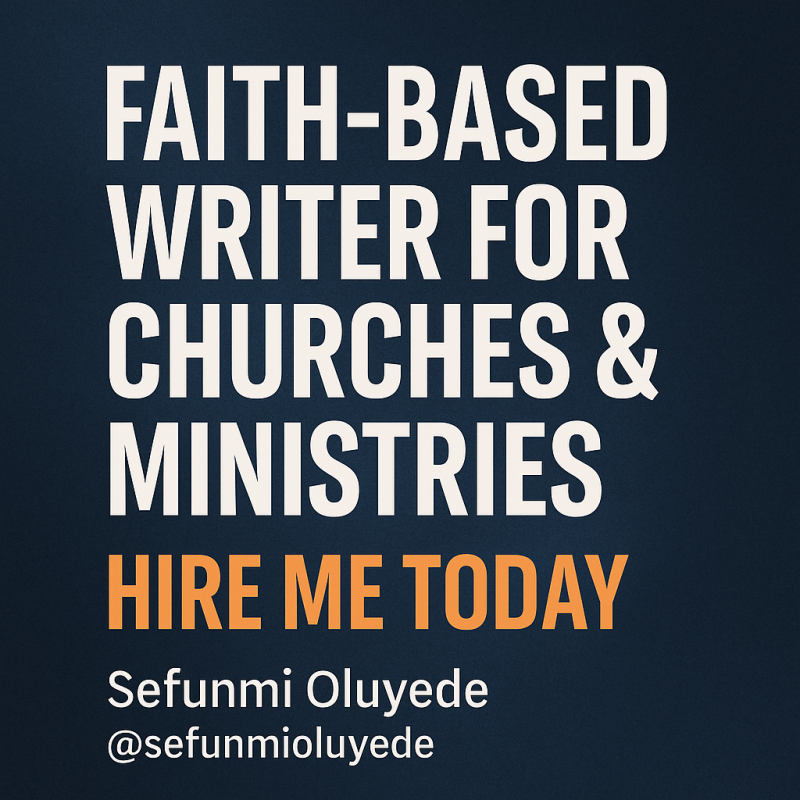
Send Money Home Smarter: Earn £30 with LemFi (Limited Offer)
Many of us in Europe send money back home to support loved ones in Nigeria, Ghana, Kenya, Uganda, or Tanzania.
But here’s the challenge: High transfer fees, Delays that keep families waiting, watching your money shrink before it even lands
That’s the reality we’ve lived with for years.
Now the solution:
I found LemFi a platform that makes remittances faster, cheaper, and now even more rewarding.
Here’s the deal: When two friends use my link to send €100 or more, I get rewarded (£10 per friend + £10 bonus).
But more importantly, they save time and money while sending funds home.
You can try it before August 31st, 2025.
Don’t just send money -make it work for you too.
#nigeriansindiaspora #africa #StarsEverywhere #internationalstudents #internationaltrade

Parenting in the Digital Age: Global Lessons, Ancient Wisdom, and the Path Forward
By Oluwasefunmi Oluyede
Parenting today looks very different from what it did even a generation ago. Digital technologies - from smartphones to social platforms - have entered our homes not just as tools, but as silent co-parents. They shape children’s learning, friendships, and even their sense of identity. The question for parents, leaders, and educators across the world is straightforward: How do we prepare children for this digital future without losing the wisdom of the past?
This article draws on lessons from Japan, West Africa, the Western world, and the Nordic countries. Each region projects a unique way of strengths and struggles for us to explore. Together, they remind us that good and successful parenting is not about choosing one cultural model, but about weaving timeless principles with modern adaptation.
Japan: Structured Independence with Hidden Gaps
Japan has earned global recognition for raising independent children in safe, community-centred environments. From a young age, children travel alone to school, supported by low crime rates and a culture of social responsibility. Parenting blends academics with character development and respect for others.
Yet, the same system reveals limitations. Fathers often remain on the margins of childcare due to work demands. The emphasis on conformity, while stabilising, can limit individuality. For outsiders, cultural norms may feel rigid or exclusive.
Lesson: Japan demonstrates the power of independence within the community, but it must create space for fathers and individuality. This need for space is underpinned by trust, a fundamental aspect of digital parenting. Trust fosters a sense of security and connection among parents, educators, and policymakers, instilling confidence in the digital parenting journey.
West Africa: The Strength of the Village, The Challenge of the Net
In Nigeria and Sierra Leone, parenting remains deeply communal. Aunts, uncles, and neighbours act as co-parents, instilling values of respect and responsibility.
But the digital shift poses new risks. In West Africa, using Nigeria and Sierra Leone as a case study, UNICEF reports show that children now access smartphones with limited supervision, leaving them vulnerable to online exploitation. In Sierra Leone, significant progress has been made with the ban on child marriage in 2024; however, economic hardship and weak educational structures hinder the country's adaptation to digital parenting.
Lesson: West Africa’s strength lies in collective parenting, but cultural wisdom must now be matched with digital safeguards.
Western World: Laws Protect, but Values Must Lead
Across Europe and North America, strong laws and child-protection frameworks are in place. Privacy regulations, parental controls, and media literacy programs aim to protect young people online, but they sometimes erode and weaken parental influence.
Children enjoy autonomy, but often without the moral guidance that laws cannot replace. A generation with more rights than responsibilities risks drifting into digital confusion.
Lesson: Strong laws matter, but nothing replaces parental modelling of values.
Nordic Countries: Equality, Independence, and Digital Literacy
Sweden, Norway, and Finland are often considered global leaders in child well-being. Their success is anchored in equality, family support systems and processes, and universal access to education and healthcare. Children are given independence early, while also learning how to navigate the digital world with resilience.
Still, challenges remain. Excessive screen time, misinformation, and growing concerns about mental health highlight that no system is immune to digital pressures.
Lesson: The Nordics remind us that balance is possible, but it requires constant vigilance. This emphasis on vigilance is a call to action for parents, educators, and policymakers, making them mentally prepared and proactive in their digital parenting strategies.
European Union: Safeguards and Equity Gaps
The EU has invested heavily in digital literacy, mandatory parental controls, and curricula designed to help young people spot misinformation. These policies show strong results in preparing children for the online world.
But gaps remain. Socioeconomic inequality limits access to technology in some areas, and the “datafication” of children’s lives raises new ethical challenges.
Lesson: Policies create strong foundations, but equity and trust remain unresolved challenges.
The Double-Edged Sword of Safeguarding
Safeguarding protects children from harm- yet over-reliance on laws and technology can weaken the parent-child relationship. Proper digital safety comes not only from tools but from trust, cultural values, and parental presence.
Timeless Principles That Still Work
- Love, but with boundaries.
- Lead by example.
- Keep storytelling alive as a moral compass.
- Encourage guided independence.
- Raise leaders who, in turn, raise leaders.
Global Lessons for Leaders, Parents, and Educators
- Governments: Invest in digital literacy and ethics in education.
- Educators: Work with parents to integrate values into classrooms.
- Parents: Stay engaged, model online behaviour, and balance freedom with empathy.
- Leaders: Encourage cultural exchange on parenting and hold technology accountable.
Conclusion
Parenting in the digital age cannot be reduced to a single formula. Each culture offers insights and lessons worth carrying forward. Japan illustrates how a culture of trust allows children to grow into independence. In West Africa, the strength of extended families and communal life continues to shape children’s values.
The Western world has leaned heavily on legal frameworks to safeguard the young. At the same time, the Nordic countries demonstrate how equality and shared responsibility can prepare children for both life and the digital space. Their success in this area offers a beacon of hope for the future of digital parenting. Across the European Union, growing attention to critical thinking shows how education is being used to counter the risks of misinformation and digital overload.
None of these approaches is complete on its own, yet together they point to a more balanced way of guiding children through the digital world. This emphasis on balance provides a reassuring guide for all stakeholders-parents, educators, and policymakers as they navigate the complexities of digital parenting, offering a clear direction and sense of guidance.
What the future demands is not perfection but inclusion-the wisdom to blend old truths with new realities. When parents and leaders succeed in that balance, we will raise children who are not only confident online but also grounded in values strong enough to carry them and those they will one day lead into the future
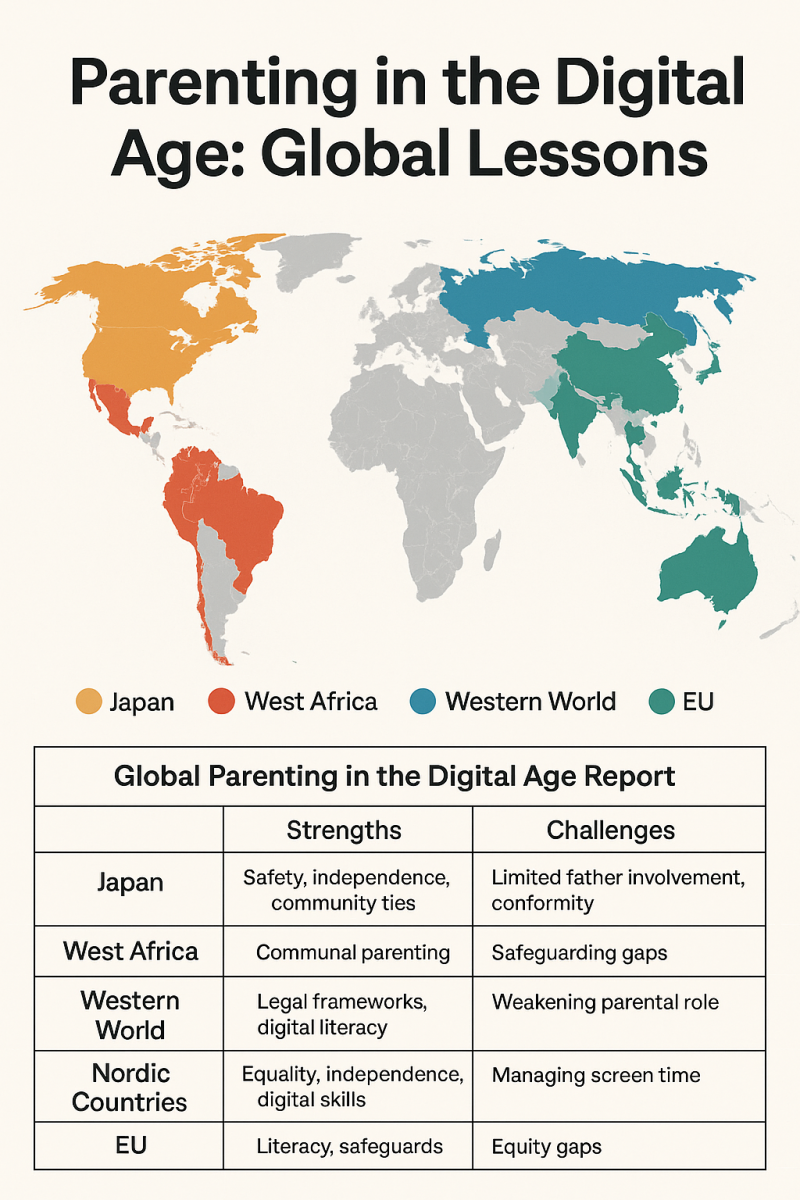
Fatigue Is a Warning: How to Prevent Stroke and Chronic Illness Through Rest
Why Ignoring Fatigue Could Be a Costly Mistake
In our fast-paced world, we often regard tiredness as a regular part of life. However, fatigue is more than just feeling sleepy - it can be a significant warning sign. Your body may be signalling stress overload, burnout, or even early signs of stroke or heart problems.
The Link Between Fatigue and Stroke
Chronic fatigue has been linked to poor cardiovascular function, high blood pressure, and even cognitive decline. Before many strokes occur, patients report intense exhaustion and fogginess - signs that often go unchecked.
The Role of Rest and Recovery
Rest is more than sleep. It includes emotional recovery, time away from screens, deep breathing, prayer or reflection, and proper sleep hygiene. These habits give your nervous and immune systems the chance to reset and protect you from long-term damage.
Signs You Should Never Overlook
Fatigue that lasts several weeks or is accompanied by dizziness, forgetfulness, or chest tightness should never be ignored. These symptoms may point to more serious issues like:
- Stroke
- Heart disease
- Diabetes
- Depression
- Thyroid disorders
Lifestyle Changes That Help
To reduce chronic fatigue and protect your health:
- Sleep 7–9 hours per night
- Eat whole foods with vitamins and fibre, such as fruits, vegetables, whole grains, and legumes, to provide your body with essential nutrients and energy.
- Take 20-minute naps when needed to recharge your body and mind, and to prevent the onset of fatigue during the day.
- Walk or exercise regularly
- Take digital breaks
- Learn to say no and set boundaries
Supporting Loved Ones at Risk
If you notice someone constantly exhausted, irritable, or withdrawn, don’t dismiss it. Encourage them to rest, reduce pressure, and seek help if symptoms persist. Your intervention could be life-saving.
About Macmillan and How to Help
Macmillan Cancer Support provides life-saving services to those battling cancer and long-term illness. They promote awareness of early signs and the importance of balance in life and recovery, offering hope and inspiration.
Visit macmillan.org.uk to donate, learn more, or get help.
Final Thoughts: Protecting Your Health Starts with Listening to Your Body
Fatigue isn’t weakness — it’s a signal. Your health deserves attention, and your body deserves rest.
If you're always pushing, always surviving, this is your reminder: stop, rest, recover. Your life depends on it.
Written by Sefunmi Oluyede
Follow for more articles on wellbeing, lifestyle, and health on
Pinterest, Medium, or contact me.


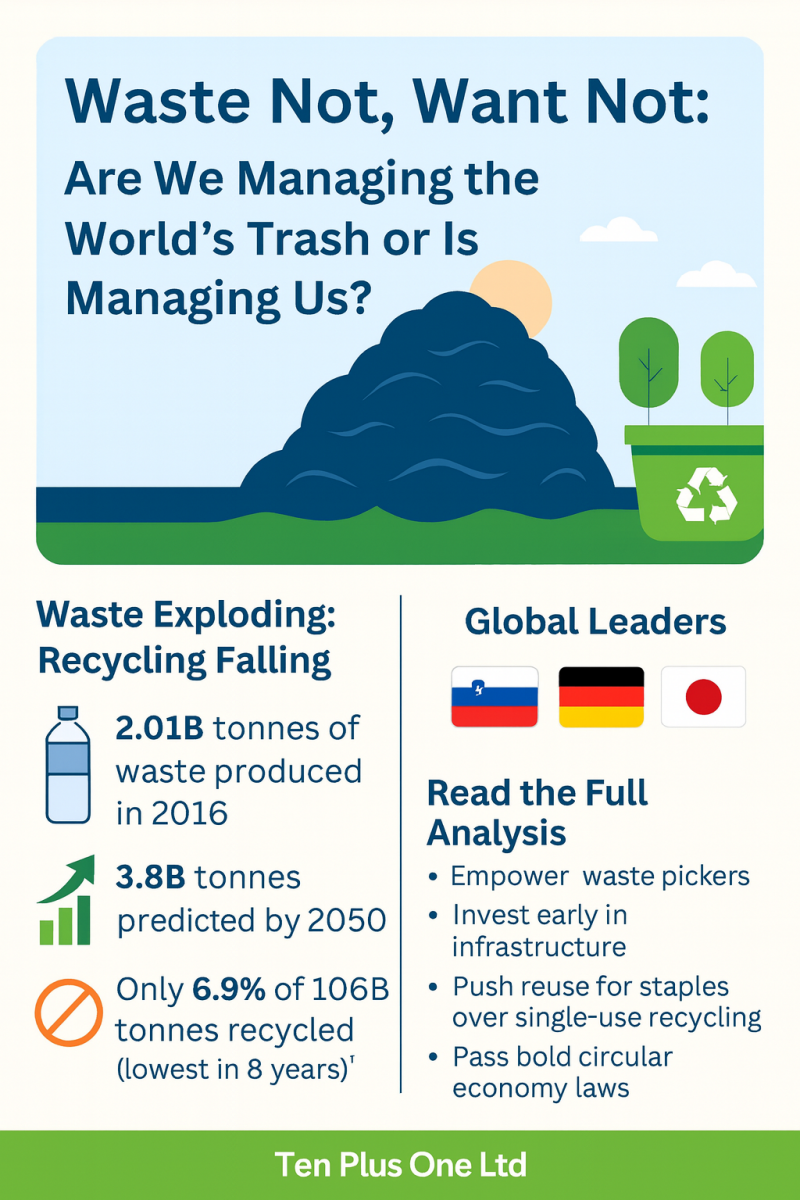
Waste Not, Want Not: Are We Managing the World’s Trash-or Is It Managing Us?
BY Oluwasefunmi Oluyede
Waste is not just a byproduct of our consumption, but a pressing issue that demands our attention. In 2016, the world churned out a threatening and staggering 2.01 billion tonnes of municipal solid waste. If we don't act now, this figure is projected to balloon to between 3.4 and 3.8 billion tonnes by 2050.
The challenge is not just scale - it’s quality. Around one-third of all waste today is mismanaged through open dumping or burning, while the proportion of materials re-entering the economy from recycled sources remains alarmingly low. This is a climate challenge, a public health issue, and, if we act wisely, a significant economic opportunity.
Some nations are demonstrating that strategic policies, modern infrastructure, and public participation can reverse the waste management crisis. By turning waste into a resource, we cannot only avert mounting costs from floods, disease outbreaks, lost tourism, and wasted resources, but also create a significant economic opportunity. The question is no longer if waste will grow, but whether we will design it out, turning today’s refuse into tomorrow’s value.
The Numbers That Matter
- Generation: ~2.01 billion tonnes in 2016 → projected 3.4–3.8 billion tonnes by 2050 if no major interventions occur.
- Management gap: Roughly 33% of global waste is handled in unsafe, environmentally harmful ways.
- Circularity pinch: The share of recycled materials in the global economy remains low, signalling an increasing strain on virgin resources.
Who’s Leading, Who’s Rising, Who’s Stuck
- Leaders: Germany, Japan, Slovenia, and the Nordic nations - high recycling rates, strong producer responsibility policies, near-zero landfill use, and high public engagement.
- Rising changers: India and Brazil - ambitious policy shifts and powerful informal sectors that keep cities functioning, though integration into formal systems remains a priority.
- Lagging contexts: High waste per capita combined with heavy landfill dependence in parts of North America and several OECD countries, as well as under-resourced cities in Africa and Asia where basic waste collection and safe disposal infrastructure remain inadequate.
Barriers to Progress
- Infrastructure & finance: Limited collection networks, insufficient sanitary landfills, and underdeveloped processing capacity. Delays in investment multiply costs over time.
- Policy & enforcement: Inconsistent regulations, weak enforcement, and market incentives that favour cheap dumping over responsible disposal.
- Culture & behaviour: Low participation in source separation, “out of sight, out of mind” attitudes, and confusion about recycling rules.
- Informal sector exclusion: Millions of waste pickers reduce landfill volumes but often lack fair pay, safety equipment, and formal recognition-leading to inefficiencies and inequities.
- Market volatility: Fluctuating prices for recycled commodities, uneven access to technology, and weak end-markets for recycled products.
Proven Solutions That Work
- Source separation at scale: Ensuring households and businesses sort waste at the point of generation to improve recycling quality and reduce contamination.
- Extended Producer Responsibility (EPR): Making manufacturers financially and logistically responsible for the end-of-life of their products and packaging.
- Formalising and supporting the informal workforce: Providing contracts, cooperative structures, protective equipment, and fair wages to waste pickers who already play a crucial role in recycling systems.
- Organics first: Rolling out citywide composting and anaerobic digestion (AD) programs to reduce landfill methane emissions and return nutrients to soil.
- Smart systems: Using data-driven route planning, AI-powered sorting, and quality control systems to maximise recovery value.
- Waste-to-Energy (WtE) with caution: Deploying modern WtE plants only for non-recyclables, ensuring strict emissions controls, and keeping the focus on reduction and reuse.
- Reuse over recycling: Prioritising refillable containers, deposit-return schemes, and repair systems, which cut emissions and resource demand more effectively than recycling alone.
- Tailored financing: Leveraging blended finance, green bonds, and public–private partnerships to build waste infrastructure early, when it is cheaper and more effective.
Why It Matters for Economies and Regions
- Risks of inaction: Increased flood damage from blocked drains, rising public health costs, reduced tourism revenue, hazardous e-waste pollution, and stranded plastic waste.
- Benefits of action: Creation of green jobs, new income streams from recovered materials, healthier cities, lower methane emissions, and greater resilience to market and climate shocks.
- Encouragement to leaders: Continue expanding EPR, scaling reuse programs, and sharing proven policies globally.
- Nudge to laggards: Start with improving waste collection and managing organics, integrate the informal sector, and then phase in EPR and advanced sorting-sequencing reforms for lasting impact.
Conclusion
Waste is more than an operational challenge, it is a systems test for governments, businesses, and communities. Nations that approach waste as a strategic issue, rather than a mere sanitation task, will gain long-term advantages in public health, job creation, climate resilience, and global competitiveness.
The solutions are not abstract. We already know what works:
- Separate at source to improve material recovery.
- Invest early in collection, treatment, and disposal infrastructure.
- Reward producers for designing products with end-of-life in mind.
- Protect and integrate the workers who keep cities clean, often without recognition.
- Scale reuse models where they outperform recycling in cost and environmental benefit.
Waste is not destiny—it is design. Our choice now is whether to continue burying and burning value, or to build systems that turn today’s refuse into tomorrow’s opportunity.
Key References
- World Bank – What a Waste 2.0: A Global Snapshot of Solid Waste Management (waste generation, composition, and global management gaps).
- United Nations Environment Programme (UNEP) – Global Waste Management Outlook 2024 (cost projections, policy pathways, and regional performance).
- OECD / Eurostat Country Profiles – Data on recycling rates, landfill use, and extended producer responsibility progress.
- Circle Economy – Circularity Gap Report (global secondary material share trends).
- Peer-reviewed and national reports on organics management, waste-to-energy emissions controls, and EPR outcomes.
About Ten Plus One Ltd
Ten Plus One Ltd develops sustainable content strategies that help governments, schools, and businesses turn the principles of the circular economy into actionable roadmaps.
Our work includes:
- Policy briefs that make sustainability practical.
- Public engagement campaigns that inspire change.
- Public engagement is a crucial part of waste management.
- Campaigns that educate and inspire communities to participate in source separation, recycling, and other sustainable practices that can significantly improve waste management outcomes.
- Data-led content that bridges research and real-world action.
- Visit: www.sefunmioluyede.com, info@sefunmioluyede.com
Share your thoughts in the comments -what’s the #1 waste challenge or solution in your country?”
Creating a Fiverr or Upwork Account:
A Guide for Aspiring Freelancers
In a world where digital jobs are reshaping the future of work, platforms like Fiverr and Upwork offer robust gateways into freelancing. Whether you’re a student, a stay-at-home parent, a professional in transition, or someone just looking to earn extra income, this article will guide you through the first steps to launching your freelance career.
1. Know Your Skills
Before signing up, take inventory:
-
Can you write? Design? Teach? Translate?
-
Are you skilled in video editing, voiceover, coding, or data entry?
Tip: Start with one or two clear services. As you grow and gain experience, you can expand your offerings and increase your rates.
2. Choose the Right Platform
-
Fiverr is great for beginners. You list your services (gigs), and buyers come to you.
-
Upwork is project-based. You bid for jobs, making it slightly more competitive but also potentially higher-paying.
3. Set Up Your Profile
Your profile is your digital CV. Here’s what to focus on:
Professional Photo – clean, clear, and friendly Headline – state your core service (“Creative Writer | SEO Specialist”) Overview – explain who you are, what you do, and why you’re trustworthy Portfolio – upload past works, samples, or mock-up projects
4. Price Your Service
For beginners:
-
Fiverr: Start at $5–$25 depending on complexity
-
Upwork: Bid lower as you gain reviews, then gradually raise rates
Reality check: Your first client may underpay, but treat it as a stepping stone to success.
5. Apply with Intention
On Upwork:
-
Read job posts thoroughly
-
Personalise every proposal
-
Attach a relevant sample.
-
Answer client questions before they ask.
6. Build Credibility
Deliver excellent work Be on time Communicate clearly Ask for reviews when the job is complete
7. Stay Consistent
Remember, getting your first job is often the most challenging. Don’t give up. Apply daily, refine your profile weekly, and learn from rejections. Patience and persistence are key. Your determination will pay off in the long run.
From My Journey: Imagine the possibilities as you start your journey. I started with zero connections and no network. Today, I write for global clients, run my brand, and help others break into the freelance world. Your journey is about to begin. Are you ready?
Want to explore more ways to earn online?
Visit: www.fiverr.com/sellers/oluwasefunmiolu/edit
https://www.upwork.com/freelancers/~01db029688e5b40353
Want help getting started? Reach out via sefunmioluyede567@gmail.com
Oluwasefunmi Oluyede
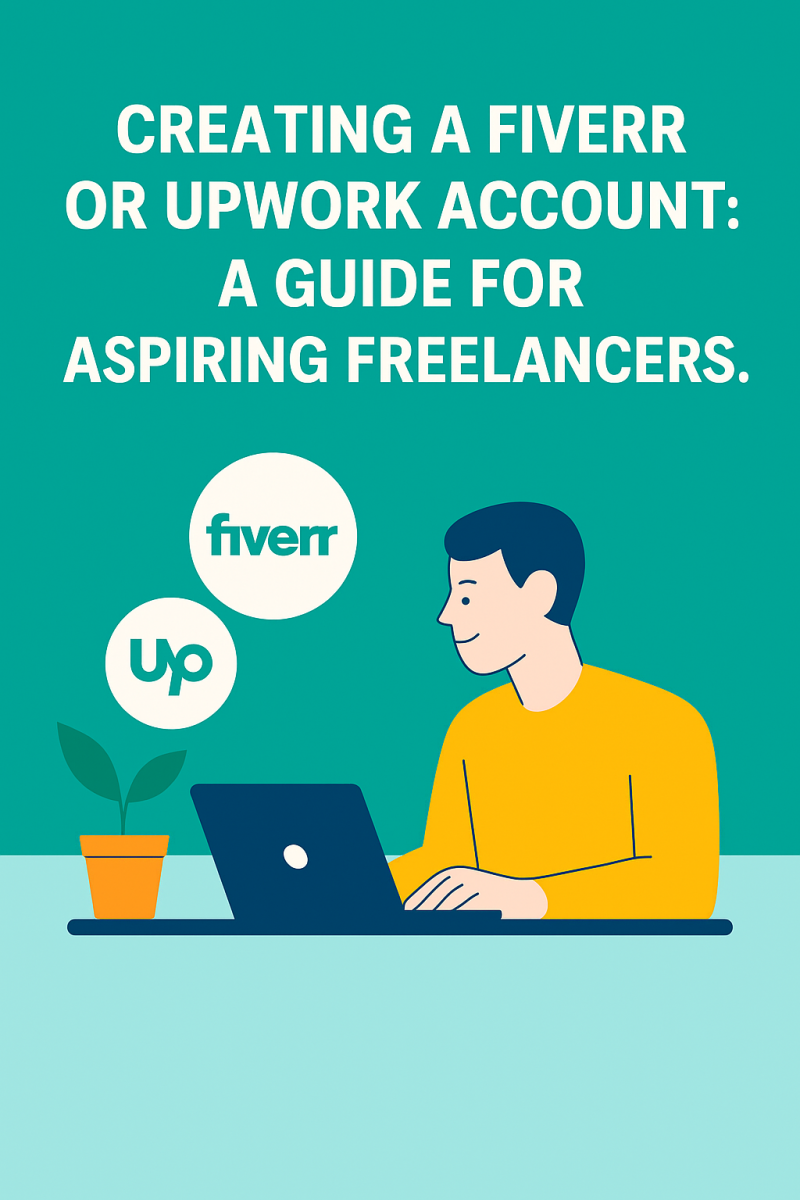
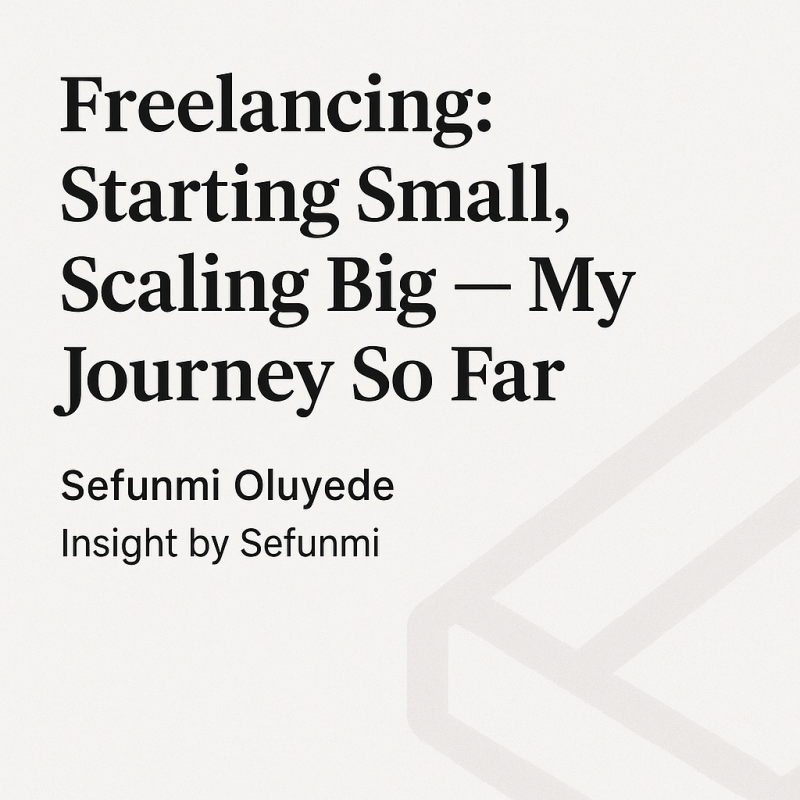
Freelancing: Starting Small, Scaling Big - My Journey So Far
When I first ventured into the world of freelancing, I was far from having it all figured out. Like many others, I was on a quest to earn a decent income while engaging in work that resonated with my passion for education, writing, and impact. The road was not easy, but it was worth it.
Despite the uncertainties, I was determined to build something real. I started small, offering writing services, helping friends with branding materials, and designing science lessons. I explored platforms like Fiverr, Upwork, and now Freelancer, with no guarantees. But my determination never wavered.
Over time, I learned a few key lessons that changed the game for me:
- Start with what you know. I began with content writing and educational design -areas I already had experience in.
- Deliver value, not just words. Clients are drawn to freelancers who understand their goals and translate that into results.
- Be consistent. Whether it’s building your profile, learning a new tool, or pitching to clients, showing up every day counts.
- Let your story work for you. People don’t just buy services - they connect with stories. Your journey is your brand.
Now, I specialise in content writing, SEO articles, branding strategy, and curriculum development. I work with schools, startups, business owners, and nonprofits - creating content that informs, inspires, and performs.
This journey is still unfolding, and if you’re just starting, remember that you're not alone. Here’s my advice:
Don’t wait for perfection. Start where you are, learn fast, stay honest, and let the results grow.
Let’s connect if you need support with your brand, educational content, or storytelling strategy. I’d be glad to help.
Oluwasefunmi Oluyede
The Power of Sustainable Innovation in Combating Climate Change
by Oluwasefunmi Igbekele Oluyede.
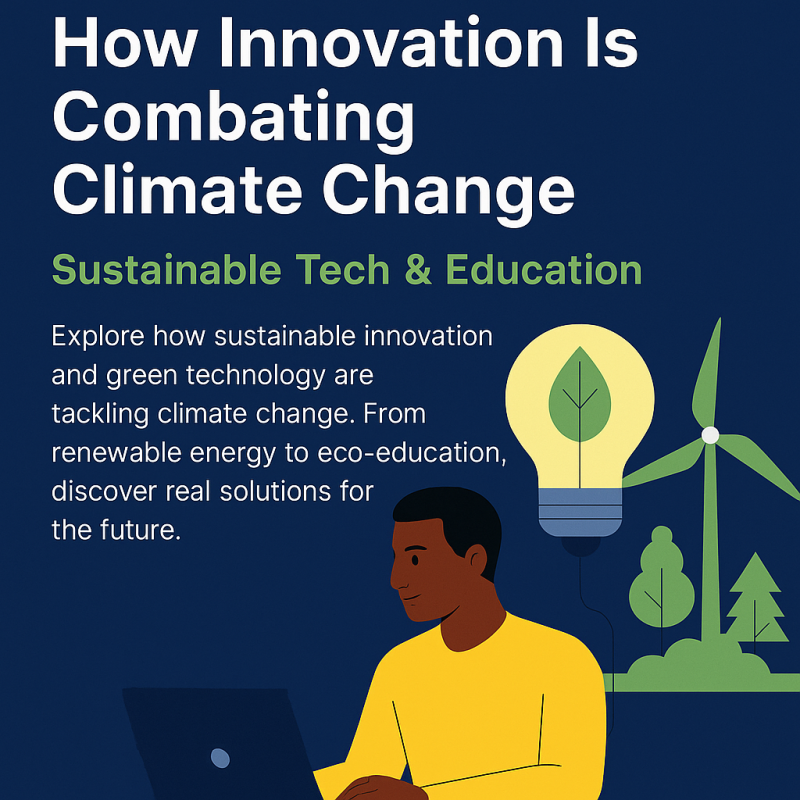

I’m honoured to share that my article on green innovation has been featured by the SGE Initiative. Below is the full version for my blog audience. Let’s keep the green conversation alive.
The Power of Sustainable Innovation in Combating Climate Change -
Climate change is an urgent global challenge, threatening ecosystems, economies, and livelihoods. Rising temperatures, extreme weather events, and environmental degradation highlight the need for bold, forward-thinking solutions. Sustainable innovation offers a transformative approach to addressing these issues by integrating technology, policy, and community-driven efforts to build a more resilient and sustainable future.
Why Sustainable Innovation Matters
Sustainability is not just about reducing carbon emissions; it is about redefining how we interact with the environment, and ensuring economic growth while preserving natural resources. A green economy champions innovations that enhance efficiency, promote renewable energy, and minimize waste, paving the way for sustainable development. By adopting these solutions,
societies can transition from environmentally harmful practices to ones that foster long-term
ecological balance.
Key Pillars of Sustainable Innovation.
1. Renewable Energy Revolution
Transitioning from fossil fuels to renewable energy sources such as solar, wind, and hydroelectric power is crucial in mitigating climate change. Breakthroughs in energy storage, smart grids, and decentralized power systems enhance efficiency and accessibility, ensuring a reliable, low-carbon future.
2. Sustainable Architecture and Urban Planning
Green buildings, eco-friendly construction materials, and energy-efficient urban planning are essential for reducing carbon footprints. Cities that integrate smart public transport, green infrastructure, and waste management systems contribute to a healthier and more sustainable environment.
3. Circular Economy and Zero Waste Models
A circular economy shifts from the traditional “take-make-dispose” model to one where products and materials are continuously reused, repaired, and recycled. Companies embracing closed-loop production reduce waste, conserve resources, and promote sustainability in industrial processes.
4. Regenerative Agriculture and Sustainable Food Systems
Agriculture accounts for a significant share of greenhouse gas emissions, but sustainable farming practices such as permaculture, vertical farming, and plant-based food alternatives can reduce emissions while improving food security and biodiversity.
The Role of Individuals and Communities: Sustainability is a collective responsibility. Communities play a crucial role in advocating for environmental policies, adopting sustainable lifestyles, and supporting ethical businesses. Grassroots initiatives, environmental activism, and consumer choices drive real change, proving that individual actions, when multiplied, have a profound impact.
The Influence of Policy and Global Collaboration.
Governments and international organisations must implement strong policies that support sustainable innovation. Incentives for green businesses, carbon pricing, and stricter environmental regulations accelerate the shift towards a low-carbon economy. Global agreements such as the Paris Climate Accord emphasise the necessity of international cooperation to tackle climate change effectively.
Conclusion: A Call to Action
The fight against climate change requires innovation, commitment, and a shared vision for a sustainable future. Sustainable innovation is not just an option, it is a necessity. By embracing clean technologies, sustainable practices, and responsible policies, we can create a thriving planet for future generations. Now is the time to act – every choice we make today shapes the
world of tomorrow.
Originally published at SGE Initiative
What are your thoughts on green innovation?
Leave a comment, share the article, and let’s act for the planet together.
📩 Need sustainability-focused content for your platform?
Contact Me

The Physics Behind The Game: How Science Shapes Modern Football
Football isn't just talent and tactics-it's a captivating symphony of science. From the mesmerising swerve of a free kick to the unpredictable bounce of a ball, physics weaves its enchanting spell every second on the pitch.
The Role of Forces in Passing and Shooting
Newton’s Laws of Motion come to life on the football field. When a player passes or shoots, they apply force- just like Newton described. That force changes the motion of the ball depending on its mass and speed.
Every kick generates force. But the air pushes back-this is air resistance. A gentle pass behaves very differently from a powerful strike, all because of this interaction with the air.
Then there’s friction. It’s the hidden opponent that slows the ball when it hits grass or turf. On dry ground, it travels farther. On wet grass, it might stop short. That’s science, not luck.
The Science of Curved Shots (Projectile Motion)
Angles, spin, and velocity shape some of the most unforgettable goals. A player curves the ball by kicking it at a precise angle, often with a spinning motion that causes it to bend mid-air.
One of the most iconic examples? Roberto Carlos’ legendary free-kick for Brazil- a shot that seemed to defy gravity. His “banana kick” was the perfect blend of power, angle, and spin. That’s projectile motion in action.
Player Movements and Balance
Staying balanced on the pitch isn’t random-it’s a testament to the precision of the players. It's all about the centre of gravity, which is the point in a body where its weight is evenly distributed and it can balance. Athletes must meticulously control their body mass, especially during tackles or high-speed turns, to prevent injuries.
From jumping to pivoting to diving headers, biomechanics is the driving force behind every move. It's why some players recover more quickly after a fall while others stumble.
Muscle force also plays a significant role. The way players train their bodies to generate quick bursts of motion is a testament to their dedication, reducing injury risk and improving overall performance.
Technology and Physics in Football
Modern football is an exhilarating blend of science and tech. Goal-line technology and VAR use cutting-edge motion sensors and precise timing to make crucial calls, adding a thrilling dimension to the game.
Even ball design has evolved. Aerodynamics, surface materials, and even stitching all affect how the ball behaves under different weather conditions.
Then there’s the future: AI boots and smart wearables track every kick, sprint, and slide. Physics isn’t just behind the game—it’s becoming part of the equipment, too.
Next time you watch a match, look beyond the goals-see the physics at work.
Want more? Follow us at Physics Digest for bite-sized science breakdowns in everyday sports.